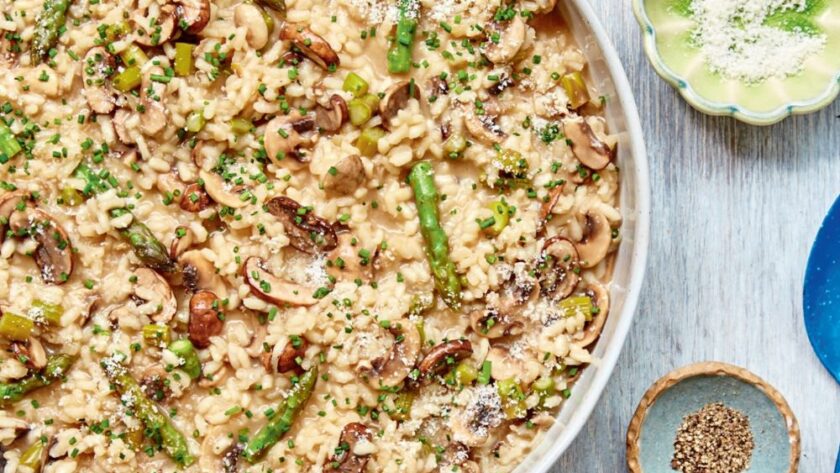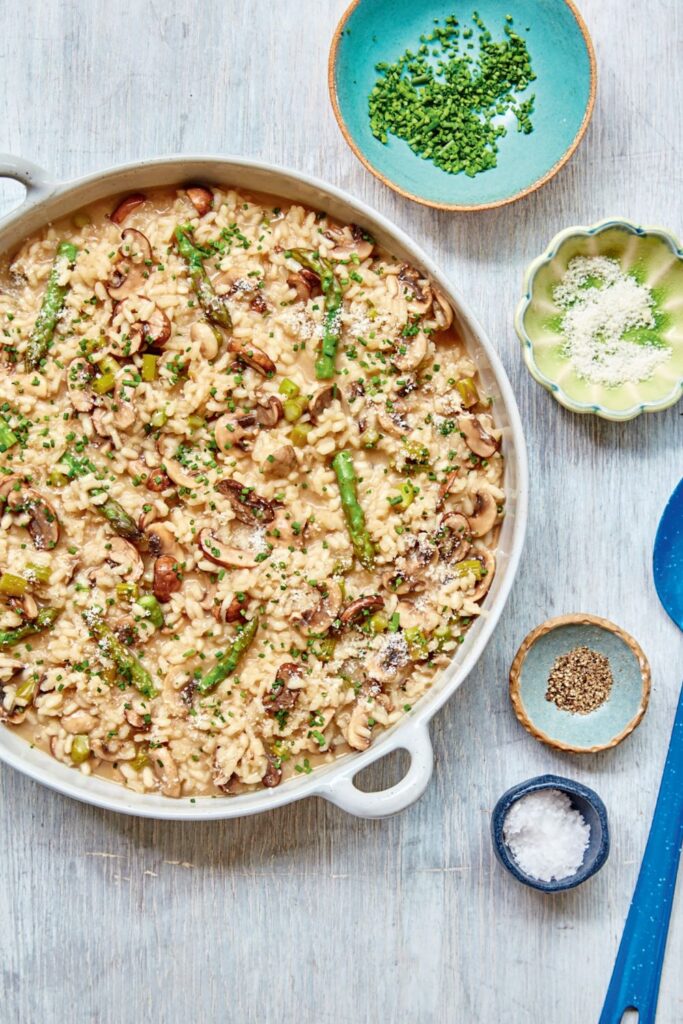The first time I made this, I thought, “Oh, it’s just risotto. Mushrooms, asparagus, rice—how complicated could it be?” Famous last words. I scorched the bottom, the asparagus turned to mush, and I forgot to keep the stock warm. It was more stress than supper.
But here’s the thing—this is now one of my midweek marvels. Once I cracked the rhythm, it became a one-pan, no-fuss comfort dish that feels a bit fancy (without trying too hard). And it’s surprisingly forgiving once you know when to stir, when to pause, and how not to kill your asparagus.
So if your risotto’s ever gone gloopy or bland—don’t worry. Let me show you how I fixed that.
WHY THIS ONE WORKS SO WELL
There are hundreds of risotto recipes out there, but Mary’s version nails the balance. Here’s what makes it shine:
- No pre-cooking faff with the mushrooms—they go in late, which keeps them juicy, not rubbery.
- Adding the asparagus in stages (stalks early, tips late) keeps the texture right. Most recipes toss it all in together, and it goes stringy.
- The wine gives lift, but the butter at the end makes it hug your spoon. I’ve tried skipping it—don’t.
INGREDIENTS + WHY THEY MATTER
- Risotto rice (Arborio or Carnaroli) – Absorbs stock slowly and releases that glorious starch. I tried regular long grain once—nope. Don’t.
- White wine – Adds acidity and depth. I’ve used both Pinot Grigio and Sauvignon Blanc. Just avoid anything sweet.
- Asparagus spears – Sliced stalks soften nicely, but tips only need a couple of minutes. Overcooked tips go grey and floppy fast.
- Mushrooms (button + chestnut) – Chestnut add earthiness. I once used only button mushrooms—it missed the savoury depth.
- Parmesan – Brings the umami and creaminess. I used a veggie hard cheese once—still decent, but not quite the same melt.
- Chives – Freshness at the end. Optional, but they wake up the richness beautifully.
- Butter – Stirred in off-heat, it’s what gives that glossy, restaurant-style finish.
MAKING IT YOURS (WITHOUT RUINING IT)
- No wine? Use a splash of lemon juice or a tablespoon of white wine vinegar, but cut the quantity in half.
- Dairy-free? Swap Parmesan with a cashew-based cheese and finish with olive oil instead of butter. It still worked, but tasted less indulgent.
- Gluten-free? You’re safe—risotto rice is naturally GF.
- More veg? I’ve added frozen peas in the final 5 minutes and it worked a treat.
- No chives? Try a sprinkle of parsley or even lemon zest if you’re feeling fancy.
MISTAKES I’VE MADE (AND HOW TO AVOID THEM)
| What Went Wrong | Why It Happens | How to Fix It |
|---|---|---|
| Rice too crunchy | Added stock too quickly | Let each ladleful fully absorb before next |
| Mushrooms watery and limp | Cooked them too early | Add only in the last few minutes |
| Asparagus turned to mush | All added at once | Slice stalks early, tips go in near the end |
| Bottom scorched | Didn’t stir or used low-quality pan | Stir regularly and use a thick-bottomed pan |
HOW TO MAKE MARY BERRY’S MUSHROOM & ASPARAGUS RISOTTO
- Prep your stock first – Keep it hot on a back burner.
- Sauté aromatics: In a wide, shallow pan, heat oil. Fry chopped onion and crushed garlic until soft and golden.
- Add rice: Stir in the risotto rice and toast it for a minute or two until slightly translucent.
- Deglaze: Pour in the wine. Let it bubble and reduce until nearly evaporated.
- Start ladling stock: Add asparagus stalks and start adding hot stock, one ladle at a time. Stir until absorbed before adding more.
- Keep stirring: After about 15–18 minutes, test the rice. It should be creamy with a bit of bite.
- Add mushrooms and asparagus tips: Stir in and cook another 3 minutes.
- Finish off-heat: Remove from heat, add Parmesan, butter, and chives. Cover and let it sit for 2 minutes.
- Serve hot: Final stir and plate up with extra cheese if you like.

TIPS FROM MY KITCHEN
- I keep a ladle in the stock pot to speed things up.
- If I’m in a rush, I use a wide sauté pan—it reduces faster.
- I add a pinch of nutmeg right at the end sometimes—sounds odd, but it works.
- Always taste before the final butter and cheese—it’s easier to adjust salt then.
STORAGE + SERVING
- Fridge: Keeps 3 days in an airtight container.
- Freezer: Okay for up to 2 months. Texture gets a bit softer when reheated, but still tasty.
- Reheat: Add a splash of water or stock on the hob or microwave until creamy again.
- Serve with: Garlic bread, rocket salad, grilled chicken, or a soft-poached egg on top if you want extra richness.
FAQs
Q: Can I make this ahead?
A: Risotto’s best fresh, but you can make it up to the Parmesan step, then finish just before serving with butter and chives.
Q: Can I use brown rice?
A: Technically, yes—but it takes forever and doesn’t go creamy. I’d skip it.
Q: Can I leave out the wine?
A: Yep! Just use extra stock with a squeeze of lemon for brightness.
Q: What mushrooms work best?
A: Chestnut mushrooms hold up beautifully and bring earthy flavour. Avoid canned mushrooms—they go spongy.
Try More Recipes:
- Mary Berry Salmon En Croûte Recipe
- Mary Berry Sunday Best Minted Lamb
- Mary Berry Chicken, Spinach and Tomato Lasagne
- Mary Berry Mushroom Risotto Recipe
Mary Berry Mushroom And Asparagus Risotto
Course: DinnerCuisine: BritishDifficulty: Easy4
servings10
minutes20
minutes447
kcalCreamy risotto with tender asparagus, earthy mushrooms, and rich Parmesan—comforting, quick, and perfect for a weeknight dinner.
Ingredients
1 tbsp (15ml) oil
1 large onion, chopped
1 clove garlic, crushed
275g risotto rice
100ml white wine
150g asparagus spears (stalks sliced, tips reserved)
800ml hot chicken or veg stock
350g mixed mushrooms (button + chestnut), sliced
75g Parmesan, grated
1 bunch chives, snipped
Large knob of butter
Salt & pepper to taste
Directions
- Heat oil in a wide pan, sauté onion & garlic until soft.
- Stir in rice, toast 1–2 minutes.
- Add wine, simmer until nearly evaporated.
- Add asparagus stalks, then stock gradually—stir constantly.
- Once rice is nearly tender (about 20 mins), stir in mushrooms & asparagus tips. Cook 3 more minutes.
- Off heat, stir in Parmesan, butter, and chives. Cover for 2 minutes.
- Stir again and serve hot.
Notes
- I keep a ladle in the stock pot to speed things up.
- If I’m in a rush, I use a wide sauté pan—it reduces faster.
- I add a pinch of nutmeg right at the end sometimes—sounds odd, but it works.
- Always taste before the final butter and cheese—it’s easier to adjust salt then.

